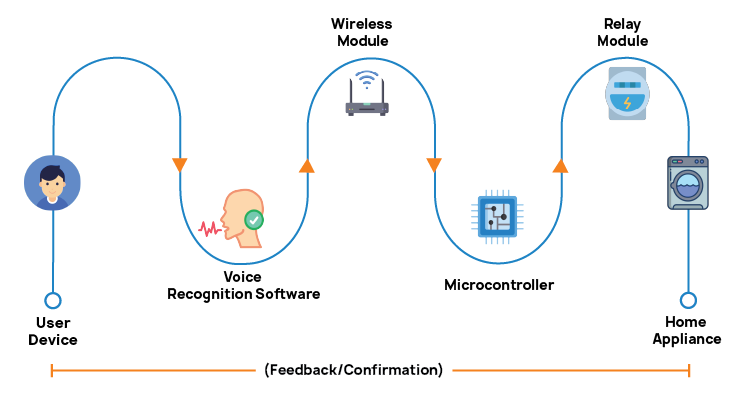

ACL Digital
5 Minutes read
Enhanced Voice and Gesture Control for home Automation
Home automation is no longer a futuristic concept, it’s here, and it’s evolving rapidly. From controlling lights through switches to managing entire homes through smartphones, technology has made daily living smarter and more convenient. Today, the latest transformation is powered by voice and gesture control, making interactions with connected devices seamless, intuitive, and hands-free. The global smart home voice control system market was valued at $6.57 billion in 2023 and is expected to reach $24.5 billion by 2033, registering a compound annual growth rate (CAGR) of 10.5% from 2026 onward. In 2025, the industry size is estimated at $134.5 billion and forecast to surge to $2.66 trillion by 2037, highlighting exponential adoption worldwide as device prices fall and AI-powered assistants become central to everyday living.
The Rise of Voice and Gesture Control
The evolution of home automation has been fascinating. Traditional switchboards gave way to touchscreens, mobile apps, and now, voice-activated assistants and gesture recognition systems. This shift reflects the growing demand for frictionless control and smarter homes. AI and IoT advancements have made it possible for devices to understand commands, respond intelligently, and learn user preferences, making life easier and more efficient.
Benefits of Voice and Gesture Control
Voice and gesture control are increasing convenience to make faster, easier, and more intuitive than ever smart home management.
Convenience
The need for remotes, switches or smartphones have decreased by Voice commands and gestures. Transform your home experience by effortlessly managing your space with just a simple command like “Turn off all lights” as you head out or with a casual wave of your hand to draw the curtains closed. Make your daily routine smoother and more enjoyable!. This hands-free convenience is especially useful when your hands are full like while cooking or carrying groceries and can save several minutes each day.
Accessibility
Voice and gesture control empower elderly individuals and people with limited mobility to manage home functions independently. It is beneficial for all ages, especially for seniors who can control fans, lights, and thermostats without moving across rooms, and wheelchair users can use gestures to open doors or turn on appliances. Studies show that accessibility-focused smart homes can improve quality of life by reducing dependence on caregivers.
Seamless Integration
These controls seamlessly integrate with smart ecosystems like Amazon Alexa, Google Home, and Apple HomeKit, connecting lights, ACs, security cameras, and entertainment systems on a single platform. For a fully connected experience combined with technology like IoT and AI. For instance, a simple command like “Goodnight” can also help a routine action that locks the doors, turns off the lights, and adjusts the thermostat all at once.
Multitasking Power
With voice and gesture control one can operate multiple devices while focusing on other activities. For example, you can skip songs while exercising with a simple swipe, or start the coffee machine with a voice command while getting ready for work. This helps improve productivity and streamlines daily routines.
Enhanced User Experience
Natural, conversational voice interactions and intuitive hand gestures make smart home control easy for all age groups, from kids to seniors. With machine learning, these systems get smarter over time, learning your habits like automatically dimming lights in the evening or adjusting the AC based on your preferred temperature making your home feel truly personalized.
Workflow of Voice & Gesture Control for Home Automation
Voice and gesture-based home automation follows a clear workflow, turning user input into real-world actions. Here’s how it works step by step:
User Device
The process begins with a smartphone, smart speaker, or gesture-enabled sensor that captures the user’s input.
Input Capture
- Voice Control: The user speaks a command like “Turn on the living room lights.”
- Gesture Control: The user performs a predefined hand movement, such as waving to switch lights on or off.
Software or Application Layer
The assistant (Google Assistant, Alexa, Siri) or a companion app processes the voice input or interprets the gesture using machine learning models and motion sensors.
Data Conversion
The captured input is converted into a digital signal or command that the system can understand and process.
Wireless Communication
The command is transmitted wirelessly through Bluetooth (for nearby devices) or Wi-Fi/IoT (for cloud-connected devices). This allows remote access and integration with multiple smart devices.
Microcontroller / Processing Unit
A microcontroller receives the digital signal. It compares the command with pre-programmed actions to decide what needs to be done.
Task Execution
Once the system matches the input to a task, it sends a signal to the relay module or relevant actuator to perform the action.
Switching Mechanism
The relay works like a smart switch, turning the connected appliance (light, fan, AC, etc.) on or off based on the received command.
Feedback & Confirmation
Some systems provide feedback like a voice confirmation (“Living room lights turned on”) or visual indication to assure the user that the task has been completed successfully.

Use Cases of Voice & Gesture Control in Home Automation
Lighting & Appliances
Easily turn lights on/off, dim brightness, or control fans and smart plugs using voice commands or a simple hand gesture. Example: Say “Turn on the living room lights” or wave your hand to switch them on when entering the room.
These automations save time and energy by ensuring lights or appliances are only on when needed. You can even create custom routines to adjust multiple lights and devices simultaneously with a single command.
Climate Control
Adjust thermostat settings or AC temperature without touching a remote or control panel. Example: Raise your hand to increase temperature or say “Set AC to 24 degrees.”
This is particularly helpful when your hands are full, like while cooking, or when you want to set the perfect room temperature before entering. It also supports energy efficiency by allowing quick adjustments to prevent unnecessary heating or cooling.
Entertainment Systems
Control music, TV, or streaming devices completely hands-free. Example: Swipe left/right to change tracks, or say “Play my evening playlist.”
With voice and gesture control, you can create a cinematic experience without searching for remotes. Imagine pausing a movie with a simple hand gesture or lowering the volume while on a call using just your voice.
Security & Safety
Lock/unlock doors, view security camera feeds, or receive real-time alerts with minimal effort. Example: Say “Lock the front door” before sleeping, or gesture to activate the security alarm.
This not only improves home safety but also provides peace of mind, especially when you’re away from home. Integration with motion sensors allows the system to alert you if unusual activity is detected.
Curtains & Blinds
Open or close curtains and blinds with just a voice command or a hand motion. Example: Say “Close the curtains” during movie night, or use a downward gesture to shut them.
Smart home automation solutions like curtains can also be scheduled to open at sunrise, promoting natural light and helping you wake up more naturally. This is a perfect combination of convenience and energy-saving.
Kitchen & Smart Appliances
Operate connected appliances like ovens, coffee makers, or microwaves. Example: Say “Preheat oven to 180°C” while preparing ingredients.
Voice and gesture control make kitchens smarter and safer, as you don’t have to touch appliances with messy hands. This also reduces the risk of accidents by allowing you to turn devices off instantly with just a command.
Conclusion
Voice and gesture control are becoming an essential part of modern living. These technologies are making our homes more intuitive, inclusive, and efficient, offering a hands-free way to manage everything from lights to security. While challenges like privacy, accuracy, and cost still exist, rapid advancements in AI, IoT, and sensor technology are addressing them quickly.
At ACL Digital, we help businesses design and develop cutting-edge smart home solutions that seamlessly integrate voice and gesture control. From concept to deployment, our expertise in IoT Solution Engineering Services, AI, and connected ecosystems make sure that your homes are not only automated but also personalized and secure.
Ready to experience the future? Start with adding a voice- or gesture-enabled device to your home today and take the first step toward a truly automated lifestyle.
Related Insights


The Architecture of Agentic RAG: Reasoning-Driven AI Systems Explained


The AI Developer’s Guide to Data Formats: TOON vs. JSON and Beyond


